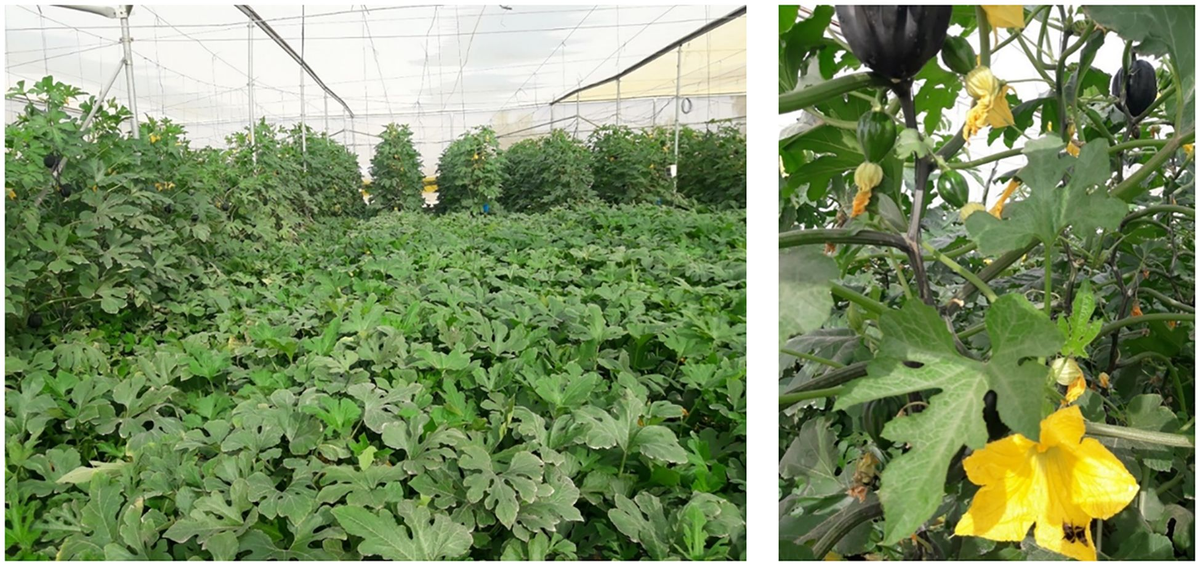Protected cultivation of squash and melons
A. Introduction
- Squash (Cucurbita pepo) and melons (Cucumis melo) are high-value cucurbit crops.
- Under open field cultivation, they are highly sensitive to temperature, humidity, and pest-disease fluctuations.
- Protected cultivation ensures off-season production, uniform quality, and higher returns.
- Both crops are well-suited for cultivation in polyhouses, net houses, and low tunnels.

B. Climatic Requirements
a. Temperature:
- Optimal range: 20–30°C.
- Fruit set reduces below 15°C and above 35°C.
b. Relative Humidity: 50–70 percent is ideal.
c. Light: High light intensity promotes photosynthesis, but shading nets (30–50 percent) are useful in summer to reduce heat stress.
d. Day length: Long days favor vine growth; balanced photoperiod improves flowering.
C. Suitable Structures
- Naturally ventilated polyhouse: For year-round and off-season production.
- Low-cost tunnels: Suitable for early-season production.
- Insect-proof net houses: Effective against viral diseases (common in cucurbits).
- Plastic mulching: Conserves moisture, suppresses weeds, and regulates soil temperature.
D. Varieties and Hybrids
a. Squash:
- Hybrid varieties suitable for protected cultivation: Hybrid Zucchini-1, Arka Tanu, Arka Vikram, Sungreen F1, Local Zucchini hybrids.
b. Melons:
- Suitable hybrids: Hara Madhu, Pusa Rasraj, Arka Jeet, Muskmelon hybrids (e.g., Kashi Madhu, Arka Rajhans, Super Sweet).
- In Nepal (Krishi Diary 2081): Recommended hybrids for cucurbits under polyhouse are high yielding F1 hybrids of muskmelon and zucchini.
E. Propagation and Nursery Management
- Seeds are sown in protrays/cocopeat media under protected nursery.
- Seed treatment with fungicides (Thiram/Carbendazim) prevents damping-off.
- Transplanting is done at 2–3 leaf stage (3–4 weeks old seedlings).
F. Planting and Spacing
a. Squash:
- Plant spacing: 60 × 60 cm (for bush types) or 1.0 × 0.6 m (for vining types).
b. Melons:
- Spacing: 1.5 × 0.5 m or 2.0 × 0.5 m depending on growth habit.
- Plants are trained on trellis/netting system to utilize vertical space.
G. Training and Pruning
Squash (Zucchini type): Usually not trained extensively; only side shoots and old leaves are removed.
a. Melons:
- Plants are trained vertically on nylon nets/strings.
- Pruning involves removal of lateral shoots up to 7th–8th node to encourage female flowers.
- Fruits are thinned, retaining 2–3 per vine for uniform size and quality
- Use of fruit nets/slings supports heavy fruits and prevents breakage.
H. Nutrient Management
- Soil is enriched with FYM (15–20 t/ha).
- Fertigation is commonly practiced under drip irrigation.
- Recommended dose (general):
a. N: 120–150 kg/ha, P2O5: 80–100 kg/ha, K2O: 100–120 kg/ha.
b. Split application: 8–10 weekly doses through drip.
- Foliar sprays of micronutrients (Boron, Calcium, Magnesium) improve fruit set and quality.
I. Irrigation Management
- Drip irrigation ensures efficient water use and prevents leaf wetting (reduces diseases).
- Irrigation frequency: every 2–3 days depending on crop stage and season.
- Mulching reduces evaporation and maintains soil moisture.
J. Pollination Management
- Both squash and melon require insect-mediated pollination.
- Under polyhouse:
a. Introduce honeybees (Apis mellifera) or bumblebees for effective pollination.
b. In absence of bees, manual pollination is practiced.
K. Pest and Disease Management
a. Major pests:
- Aphids, whiteflies, fruit flies, spider mites, leaf miners.
b. Major diseases:
- Powdery mildew, downy mildew, Fusarium wilt, viral diseases (CMV, ZYMV).
c. Integrated Management:
- Use of insect-proof nets.
- Yellow sticky traps for whiteflies.
- Neem oil sprays as prophylactic.
- Fungicide sprays: Wettable sulphur (powdery mildew), Metalaxyl + Mancozeb (downy mildew).
- Virus management through resistant hybrids and strict vector control.
d. Harvesting and Yield
a. Squash:
- Harvest tender fruits 5–7 days after fruit set.
- Yield potential: 20–25 t/ha under polyhouse.
b. Melons:
- Harvest at full slip stage (fruits detach easily) or 30–35 days after fruit set.
- Yield potential: 30–35 t/ha under protected cultivation.